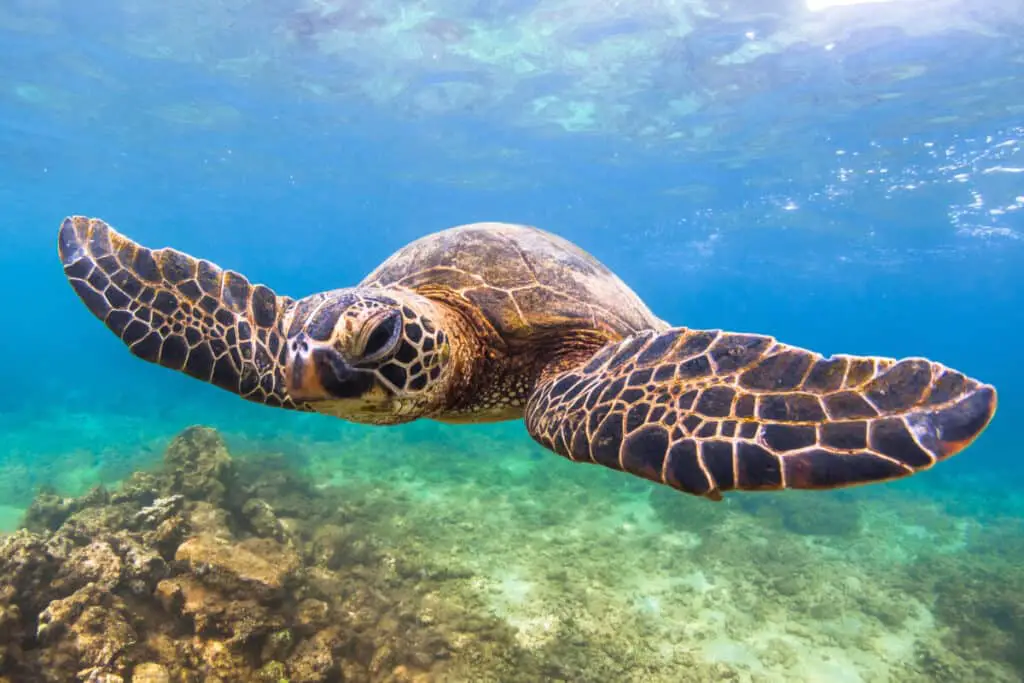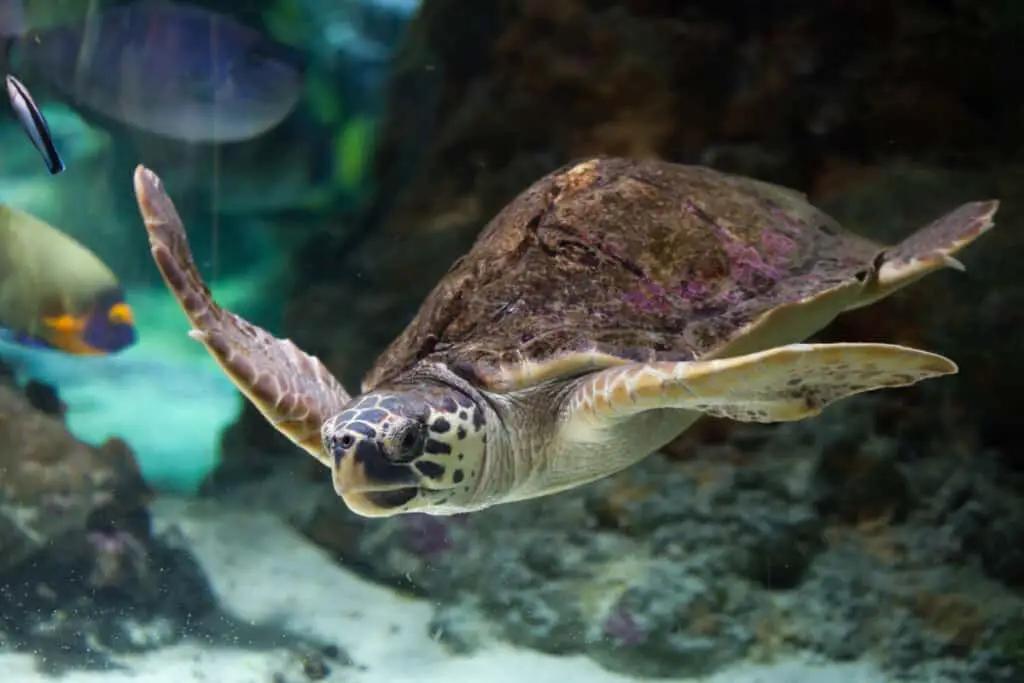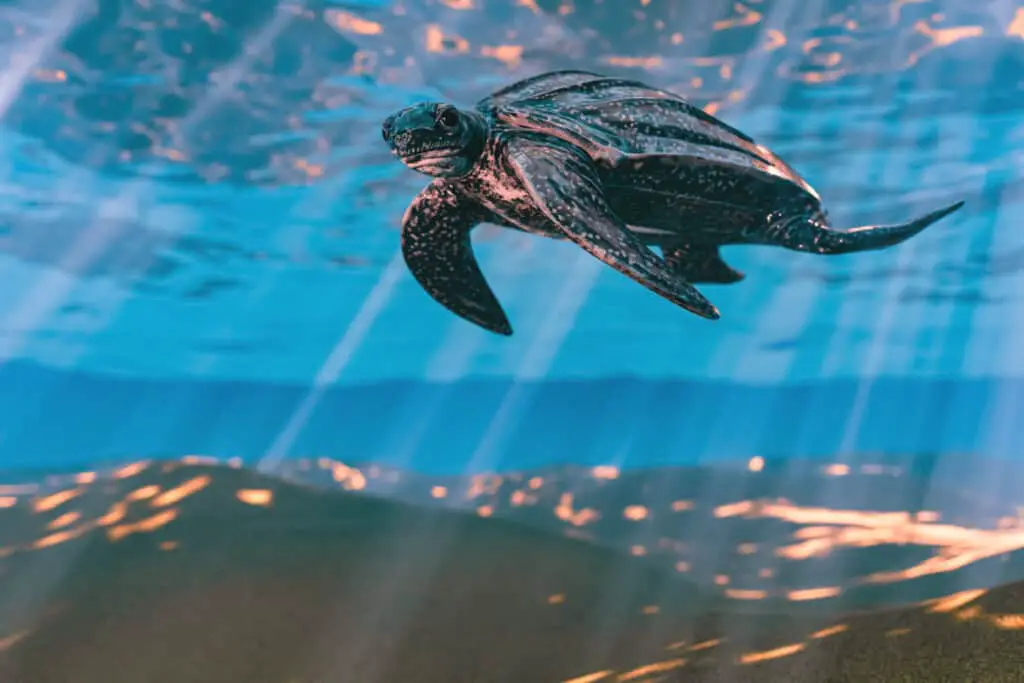
Sea turtles are usually aquatic species, which means they’re not meant to move on land. However, they have instances when they spend time on land, such as moving from one water body to another, moving away from predators, or traveling to find food. Semi Aquatic turtles have short, stubby legs with semi-square feet since they spend considerable time on land.
So, are sea turtles slow?
As a general role, sea turtles are slow swimmers, traveling at between 2.8km to 10km/h. Different species have varying speeds, with the leatherback sea turtle being the fastest ever recorded swimmer, clocking speeds of 22mph or 35km/hour as per San Diego Zoo. It’s important to mention that sea turtles can accelerate in brief bursts, for example, when frightened.
As hatchlings, the sea turtles can propel themselves on the beach as they escape predators. Female sea turtles also travel to the beach during nesting. Although their legs are not built like land-dwelling tortoises, they move a little more quickly on sand than on other surfaces, thanks to their flappers. The flappers are strong to enable them to swim powerfully and dig large holes. The hatchlings come out of the shell, ready to race to the sea. And although they have curved appendages from being curled in the shell, their instinct is to move fast to evade predators and get to the sea.
In the sea, turtles swim many miles, especially during the growth phase. Both males and females do rarely come out of the water until breeding age. Naturally, their flippers and muscles are built to swim and not to roam on land.
When Do Sea Turtles Move Fast?
There are instances when sea turtles move faster. The first instance is when hatchlings are moving from their nest to the sea. During this time, the fear factor and instinct to get into the water makes them move fast on land.
The second instance is when the female sea turtle is looking for a place to make a nest. You’ll find them moving faster during this time to avoid getting spotted by predators in their unnatural habitat.
Why Do Turtles Move Slow On Land Than In Water?
Terrestrial turtles such as box turtles are built for moving on land and thus are slightly different from aquatic turtles. The dissimilarity between aquatic and terrestrial turtles reflects on their diet, moving style, needs, etc. For now, we won’t dwell too much on their differences; let’s talk about why turtles are generally slow on land:
- Most terrestrial turtles are herbivorous or omnivorous, which means they eat both plants and animal-based foods. Therefore, they do not need to prey or hunt to survive as their foods are abundant. Why should they run yet they can get their meals without struggles?
- Since most turtles live in the water, they have more enemies in their natural habitat than on the land. However, when on land, turtles can barely outrun their predators and thus use their natural shield, which is their hard shell, to hide their chewable parts. Whenever a turtle sense danger, it curls up into its shell and waits until it’s safe. Very few creatures can break a turtle’s shell. It takes a lot of pressure to damage a turtle shell. Therefore, since the shell provides protection, the turtles do not need to run fast on land.
- Another reason turtles are slow on land is because of their body structure. Their shell is pretty heavy, and carrying it with their tiny legs requires a lot of energy. Due to this weight, their legs cannot run fast. In addition, turtles have a different moving style. Most animals lift their bodies or feet when walking, which increases speed. However, turtles cannot lift their bodies higher, making them walk as though they are dragging their limbs, thereby making them move slowly.
- The fourth reason turtles move sluggishly on land is because their limbs are made to be flippers and not legs for walking on the ground. The sea turtles come to the land when they want to lay eggs or migrate to another water body.
- Turtles also tend to move slowly to avoid damaging their shells. Imagine a situation where a turtle moves fast and falls badly, leading to shell breakage. Dents and bruises on a turtle shell encourage infections and lead to rotting.
But there is an exception
The softshell turtle. Yes, all turtles are slow on land, but some aquatic turtles exhibit different abilities, such as the softshell turtle. These turtles can move at speeds of up to 3mph – almost as fast as human beings.
Softshell turtles can move fast on land due to having a lighter shell. Also, their bodies are slightly different. For example, they have muscular legs that are made for speed.
Some aquatic turtles can also move faster on land than terrestrial turtles because of having unstable gaits. Since they are not built for moving on land, they tend to lose some balance and thus keep switching their body balance between the rear and front limbs. This tends to make them move forward fast.
Another exception is when the turtle wants to outrun a predator or when they are after something.
Understanding Turtles Bone Structure and Its Impact on Their Movement
A sea turtle has a skeleton composed of cartilage and bones. The carapace, which is the outer shell, is bone-like, and the ribs and vertebrae are bones. The plastron underneath comprises skeletal material, shoulder material, and ribs. It remains flexible but strong. There are also hind limbs, front flippers, and supporting structures.
The flippers have strong muscles and ligaments that make it easier for turtles to swim. The muscles are called flipper abductor muscles, flipper retractor muscles, and flipper protractor muscles.
There is a humerus bone on the forelimb, just as is the case with the upper bone on a human arm. There’s a radius and an ulna on the lower limb, just as is the case with bones in the human wrist.
Sea turtles have toes with metacarpals, carpals, and phalanges, all similar to bones on a human hand.
The flippers are not made for walking but swimming. In males, the bones and muscles on their flippers allow them to keep the female in place during mating.
Overall, the turtles’ bone structure is not meant for walking fast on land. The flippers help a turtle navigate in the water and dig nests.
Why Are Most Animals Faster Than Turtles?
Most animals are always in a hurry, majorly because they’re looking for food or escaping predators. So, why are they fast than turtles? Except for the fact that turtles carry their houses with themselves, there is another reason turtles are slow.
The experts blame the turtle’s slow speed on their metabolism. Turtles require less energy to move from one place to another as compared to other creatures. A slow metabolism will result to slow speeds.
However, this comes at an advantage – slow metabolism makes turtles live long. Certain byproducts of metabolism are known to increase aging.
Do Sea Turtles Swim Fast?
Seat turtles can swim at an average speed of between 3km/h and 10km/h. However, when they sense danger, they can accelerate to hit 35km/hr.
Although the 35km/h speed is a pretty big difference from the average speed, you might still not consider it fast.
Generally, turtles like to cruise through the waters as that’s how they can find crabs and yummy jellyfish to munch on. They are also very aware of their surroundings, and thus it’s hard for them to be caught unaware.
We can term them as powerful swimmers as opposed to fast swimmers. Several features make sea turtles hydrodynamic.
Firstly, their head and four limbs do not retract into the shell-like it’s the case with the tortoise as they are fixated outside the shell. In addition, they have strong front limbs that they use as flippers to steer themselves forward. The back flippers are smaller to help them steer. Thirdly, they have a streamlined shell that’s shaped in a way that reduces friction.
Another reason why sea turtles are considered powerful swimmers is due to their body’s ability to conserve oxygen. These creatures require air to breathe and thus must surface to get oxygen. However, they can hold their breath for 4-7 hours when relaxed. The number of hours varies depending on the size and species of the turtle. Also, their heart rate can slow down to beat once every nine minutes.
How Fast Do Different Sea Turtle Species Swim?
As we mentioned earlier, sea turtles are made differently. There are currently seven sea turtle species, and all have different habits and abilities.
Let’s talk about these species and how fast they can swim.
Green Sea Turtle – How Fast Can They Swim?

Considered the largest of the hard-shelled sea turtles, green sea turtles can grow their shells to 1.4 meters in length and weigh up to 159kgs. Averagely, green sea turtles cruise at 3km an hour, but research shows that these creatures can hit 30km/hour when frightened. However, it’s rare to find them clocking these speeds since they like to cruise in coastal and wide-open water bodies.
Among the seven sea turtle species, the green sea turtle is the only herbivore creature. All the rest are omnivorous, which means they feed on vegetation and animal foods such as plankton, jellyfish, and other lobsters.
It’s important to mention that green sea turtles are omnivorous when young, but they grow to be vegetarians. They derive their name from the algae and vegetation they consume and their shell color.
Loggerhead Sea Turtles – How Fast Can They Swim?

The loggerhead sea turtle is closer to green sea turtles in terms of their size, and they derive their name from their log-shaped heads. These sea turtle species can clock speeds of 24/km per hour but prefer to cruise at an average speed of 1.6km/hour.
Loggerhead sea turtles are a crucial species in their ecosystems. They are considered keystone species, which means that other animals in their ecosystem depend on them for survival. They pass out shells of invertebrates they feed on, and other animals consume these at the bottom of the ocean.
Leatherback Sea Turtle – How Fast Can They Swim?

Considered the fastest-moving reptiles, leatherback sea turtle made it to the 1992 Guinness Book of World Records, having clocked 35.28km/hour. However, this is not the average speed they move it – leatherback sea turtle cruise at an average speed of 10km/hour.
Leatherbacks also take another trophy of being the largest turtles on the planet, and their shells can grow up to two meters long and weigh over 900kgs. They got their name from their unique shell, which is semi-flexible – the shell has a leathery, waxy feel. Its weight and leathery carapace help them dive deep – they can dive to a depth of 1000m.
The other sea turtle that can rival the leatherback sea turtle is the Archelon, a giant turtle that reached four meters in length, having lived about 66 million years ago.
Hawksbill Sea Turtle – How Fast Can They Swim?

Hawksbill sea turtles can be categorized among the smaller species as their shells do not exceed one meter in length. They weigh about 68kgs and can move at 24km/hour. These are powerful swimmers and can swim for thousands of kilometers.
What’s the Average Distance Turtles Swim?
Sea turtles are powerful swimmers thanks to their strong flippers and ability to hold breathes for many hours. They can travel across long distances in search of food or a place to make a nest.
Although there’s not enough research on how far sea turtles swim, historical data shows that the Loggerhead turtle Adelita traveled about 12,000 kilometers. Adelita was tracked from Mexico to close to Japan across the Pacific Ocean.
Are Sea Turtles Fast In Currents?
Although there’s not enough research to determine the speed of turtles in currents, it’s known that turtles ride the waves to make long trips across oceans.
For instance, Dr. Michelle Boyle, a marine biologist, discovered that Australian Loggerhead turtles were making trips across the Pacific Ocean by riding the East Australian Currents. That’s about 20,000 kilometers. Although it’s yet to be determined if this is common among other turtle species and the speed at which they actively move, the current discovery by Dr. Michelle has laid grounds for further research.
Interesting Facts About Sea Turtles
Most of the information regarding sea turtles remains a mystery, but scientists have discovered more about their lives.
Here are ten scientific facts about turtles:
- There are seven turtle species in today’s world, including the loggerhead, leatherback, hawksbill, flatback, olive ridley, Kemp’s ridley, and green turtles.
- Sea turtles are categorized as reptiles and thus are in the same category as lizards and snakes. They’re known to have evolved about 150 million years ago and thus survived the age of dinosaurs. At that time, turtles were land animals and looked more like tortoises of today’s world as they had column-like legs that supported their heavy shells. However, they evolved and developed flippers, which now made them aquatic species. Today, turtles can swim in many parts of the oceans.
- The shell is the most conspicuous part of a turtle, although the tough skin protects its flippers, tail, and head. The shell has nerves and thus a sensitive part.
- Sea turtles are hatched from the leathery-shelled eggs that the female turtles lay in the sand. A female may produce between 50 to 200 eggs at once. These eggs take about 60 days to hatch. After hatching, the babies don’t take long before racing towards the sea. They often encounter different predators, including raccoons, gulls, crabs, and sharks. A female can lay as many as eight clutches in a breeding season, with only one hatchling per 1000 (on average) managing to survive into adulthood.
- After hatching, baby turtles race to open sea and only come out when looking for food. Some species travel hundreds of miles from where they are hatched. However, the flatback sea turtle does not leave their Australian shores.
- The leatherback is the largest sea turtle. It got its name from its leathery shell and can reach a length of up to 4-8 feet. These creatures can weigh 500-2,000 pounds. The main reason for this growth is due to their appetite for jellyfish. It can go down to a depth of 4,000 feet and swim hundreds of miles in search of food. They can migrate 3,600 miles from where they were hatched.
- The Kemp’s ridley is the smallest sea turtle, measures less than 30 inches long, and weighs less than 100 pounds. They are natively found in Rancho Nuevo in Mexico. This turtle species typically lay eggs during the day, and they do so in large groups called arribadas. In the past, these groups could comprise over 40,000 females. However, due to the uncontrolled collection of eggs, these numbers have reduced. To help prevent these species from becoming extinct, the Mexican government enforced strict provisions regarding egging. Biologists also keep these turtles in captivity and help them breed. They later release them from the beach after reaching survival age.
- All sea turtles start as omnivores when young, but only the green sea turtle becomes herbivorous when they become adults. Other turtles remain omnivorous, feeding on sponges, worms, fish, and other sea life. Leatherbacks eat jellyfish almost exclusively.
- Turtle’s average lifespan is hard to estimate, given that many turtles outlive their owners, and there aren’t many research projects detailing this. Little research on turtles’ age suggests that turtles start breeding between the ages of three and 50 and may live for up to 100 years, although more research needs to be done regarding turtle’s lifespan.
- Sea turtles can hold their breath for up to two hours underwater. They do this when evading predators or looking for food. Keep in mind that turtles need to surface to breathe air more frequently when relaxed.
Conclusion
Sea turtles remain nature’s mystery, and scientists are only beginning to discover their secret lives. These creatures are not built for walking on land – their flippers are designed for swimming, which means they’re fast in water than on land, except for when they are moving out of the nest racing to the open sea and when the female is looking for a nesting place.
Averagely, sea turtles can swim between 2.8km/h and 10km/h. When frightened or being chased, sea turtles can swim as fast as 35km/hr.
So, are turtles slow? Well, they are slow on land but not so much in the water. We’ve talked about why turtles are slow on land, with the primary reason being body structure.
